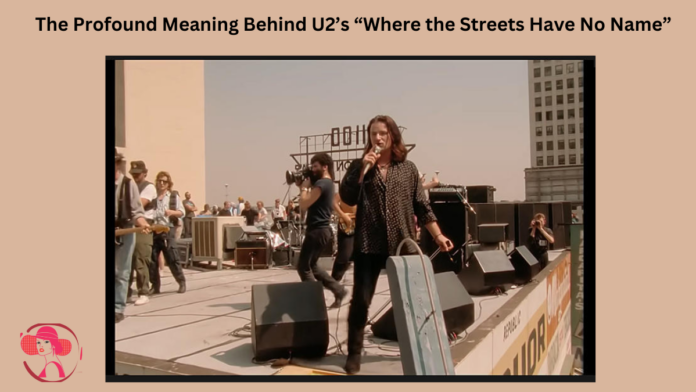U2, led by Bono, has always been celebrated for their introspective lyrics and meaningful themes. Their album The Joshua Tree, which includes some of their most iconic songs, holds a special place in music history. Notably, it became the fastest-selling album in both the U.S. and U.K., making a significant impact worldwide.
“Where the Streets Have No Name” is the opening track on this album and serves as a powerful introduction to its themes of searching for freedom, unity, and an escape from societal boundaries. Let’s dive into the historical and emotional layers behind this unforgettable anthem.
A Song Inspired by Belfast
In U2’s 2009 biography, U2 By U2, Bono describes “Where the Streets Have No Name” as a quest for “a place of imagination, where there are no limitations.” He was inspired by the city of Belfast, Northern Ireland, and the restrictive societal norms embedded in its culture. Bono’s lyrics evoke the feeling of wanting to break free from societal labels and divisions.
- Background on Belfast: Known for its deeply rooted social and religious values, Belfast has a unique culture where a person’s street address often reveals their religion and socioeconomic status. This geographical divide fuels a sense of entrapment, a theme Bono sought to capture in the song.
- Quote from Bono: “A feeling of wanting to break out of that city and wanting to go somewhere where the values of the city and the values of our society don’t hold you down.”
A Divided City: The Roots of Societal Disparity
The inspiration behind the song is not just about geographical boundaries but also a deeply entrenched history of sectarian division. Here’s a breakdown of the historical context that shaped the song’s powerful message:
| Historical Event | Description |
|---|---|
| Irish War of Independence (1919-1921) | Marked the split of Ireland into two separate entities, leaving Northern Ireland under British rule and deepening divisions between Catholic and Protestant communities. |
| Partition of Ireland | Catholics (Nationalists) and Protestants (Loyalists) formed tightly knit communities, with religion and politics shaping neighbourhood boundaries and social dynamics. |
| Social Division in Belfast | Catholics (Nationalists) and Protestants (Loyalists) formed tightly knit communities, with religion and politics shaping neighborhood boundaries and social dynamics. |
The Lingering Effects of Religious and Social Prejudice
More than a century later, the effects of these conflicts remain visible in Northern Ireland. Social disparity and geographic segregation are apparent in cities like Belfast, where community divisions continue along religious and economic lines.
- Visible Social Disparity: Streets and neighbourhoods still reflect social and religious divides. For instance, houses on certain streets or on specific sides of hills can indicate a person’s wealth or community affiliation.
- Cultural Impact: These divisions highlight how historical conflicts shape present-day Belfast, influencing even the unspoken values held by its residents.
The Emotional Power of “Where the Streets Have No Name”
Through this song, U2 channels the energy of Belfast’s divided streets and conflicted history. Bono’s lyrics aim to transcend these boundaries, seeking a space where such divisions no longer exist—a place where identity isn’t dictated by street names or neighborhood affiliations.
Why This Song Resonates Today:
- Universal Appeal: The song speaks to anyone who has felt constrained by societal expectations or divisions.
- Timeless Message: Although inspired by Belfast’s history, the theme of unity over division remains relevant around the world.
- One of the Greatest Songs of All Time: “Where the Streets Have No Name” is celebrated not only for its music but for its poignant exploration of freedom and belonging.
Final Thoughts
U2’s “Where the Streets Have No Name” is a testament to the band’s ability to turn historical pain and division into a powerful message of hope. It’s a reminder that, despite our differences, a universal desire exists for unity—a place where the streets and everything they represent have no name.
Click here to learn more















